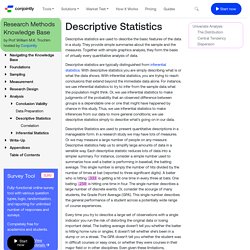

Qualitative Analysis. Quantitative Analysis. Inferential Statistics. « PreviousHomeNext » With inferential statistics, you are trying to reach conclusions that extend beyond the immediate data alone.

For instance, we use inferential statistics to try to infer from the sample data what the population might think. Or, we use inferential statistics to make judgments of the probability that an observed difference between groups is a dependable one or one that might have happened by chance in this study. Thus, we use inferential statistics to make inferences from our data to more general conditions; we use descriptive statistics simply to describe what's going on in our data. Here, I concentrate on inferential statistics that are useful in experimental and quasi-experimental research design or in program outcome evaluation.
Most of the major inferential statistics come from a general family of statistical models known as the General Linear Model. One of the keys to understanding how groups are compared is embodied in the notion of the "dummy" variable. PHAC SUR2: Communicating Data Effectively. To take any Skills Online module you must complete a technology orientation.

First-time learners who register for any of the facilitated modules will automatically be registered in the mandatory orientation. For detailed descriptions click on the module titles below. Skills Online offers self-directed and facilitated modules. Self-directed modules can be taken at any time. Facilitated modules must be completed by the session end date. Facilitated modules Upcoming sessions: Spring 2014, register: March 24 to April 20. PHAC STA1: Introduction to Biostatistics. To take any Skills Online module you must complete a technology orientation.

First-time learners who register for any of the facilitated modules will automatically be registered in the mandatory orientation. For detailed descriptions click on the module titles below. Skills Online offers self-directed and facilitated modules. Self-directed modules can be taken at any time. Facilitated modules must be completed by the session end date. Facilitated modules Upcoming sessions: Spring 2014, register: March 24 to April 20 Course dates: May 12 to July 6, 2014 Fall 2014, register: July 21 to August 17 Winter 2015, register: November 17 to December 14, 2014 Self-directed modules (no fee) PHP1 Introduction to Public Health in Canada PHP4 Introduction to Literature Searching Basic Epidemiological Concepts (EPI 1) Required effort: approximately 26-33 hours No prerequisite Builds competencies in Public Health Sciences and Assessment and Analysis. Register now Measurement of Health Status (EPI 2) Purpose.
Descriptive Statistics. « PreviousHomeNext » Descriptive statistics are used to describe the basic features of the data in a study.

They provide simple summaries about the sample and the measures. Together with simple graphics analysis, they form the basis of virtually every quantitative analysis of data. Descriptive statistics are typically distinguished from inferential statistics. With descriptive statistics you are simply describing what is or what the data shows. Descriptive Statistics are used to present quantitative descriptions in a manageable form. Every time you try to describe a large set of observations with a single indicator you run the risk of distorting the original data or losing important detail. Univariate analysis involves the examination across cases of one variable at a time.